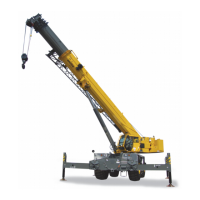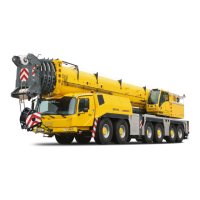Grove Published 11-22-2016, Control # 345-12 2-19
RT9130E-2 SERVICE MANUAL HYDRAULIC SYSTEM
5. Place your hand on the pump to check for excessive
heat buildup caused by binding or other problems. If the
pump is too hot to keep a hand on, stop the engine.
Each section should feel about the same warmth, but
pressure drops in each pump section’s circuit would
explain some difference between sections.
6. Listen for abnormal noises indicating low hydraulic oil
level or internal pump problems. If the pump is making
excessive noise, it is probably sucking air into its inlet,
keeping it from priming. In case of abnormal noise, stop
engine, and inspect the pump and the suction line for a
loose connection, a leak, or a damaged or missing O-
ring.
7. If the pump seems to be running properly, increase the
rpm to 1500 to 1800 rpm for one to two minutes while
operating no hydraulic functions. Repeat checks in steps
4, 5, and 6.
8. Increase engine speed in steps to full RPM. Repeat
checks in steps 4, 5, and 6.
9. Cycle the components the pump sections power to verify
the pump sections drive them properly. Verify there is no
leaking.
10. Check pressure settings. Refer to Pressure Setting
Procedures, page 2-21.
CAUTION
If the pump becomes hot to the touch, it is binding and
may seize. Stop the engine, disassemble the pump, and
repair it so it will not bind.
CAUTION
For Pump No. 2, pay special attention to the service brake
charge pump if your crane has the dual accumulator
charging valve for hydraulic service brakes.
If the dual accumulator charge is set too high, the pump
will continually push all its flow through an integral relief
valve that dumps the heated fluid back into the pump’s
inlet. This causes a “hot loop” problem that will very
quickly heat the pump section above hydraulic reservoir
temperature. If this happens, stop the engine immediately.
Adjust the dual accumulator charging valve socket head
screw in the valve’s tank port, out (CCW) to lower the
pressure. (See Procedure E of the Pressure Setting
Procedure portion of this section.)
Restart the engine; listen for the dual accumulator charge
valve to cycle on and off (cycle changes one to two
seconds.) Perform Step 5 again.

